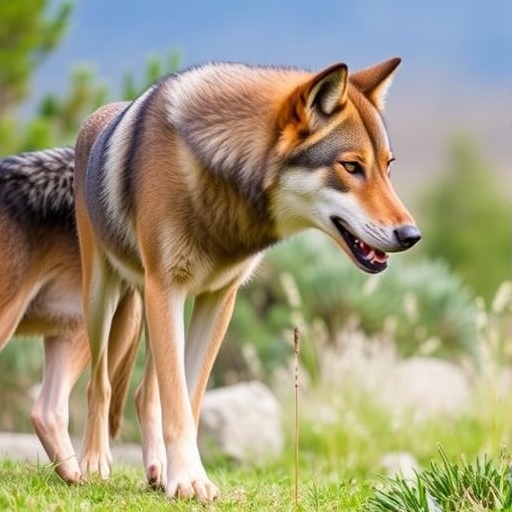
A groundbreaking study led by researchers at the University of California, Berkeley, has unveiled unprecedented insights into the behavior of gray wolves in Yellowstone National Park, challenging long-held assumptions about predator and prey dynamics in rugged, mountainous ecosystems. For the first time, these biologists have documented gray wolves undertaking long-distance migrations, traveling upwards of 20 kilometers across difficult terrain with very young pups in tow — a behavioral adaptation previously thought exclusive to Arctic wolf populations.
Gray wolf pups are born utterly vulnerable — blind, deaf, and lacking the sophisticated sensory capabilities of adult wolves. Typically, these pups remain close to the safety of their dens for a minimum of three weeks, sheltered from external threats. However, this study reveals that packs near Yellowstone are defying these safety norms. They are journeying substantial distances alongside their pups during the spring months, aligning their movements with the seasonal migration patterns of their primary prey: elk.
These findings confront a prevailing dogma within carnivore ecology, which posited that migratory herbivores could evade predation during vulnerable life stages because predators were tied to stationary dens and immobile offspring. UC Berkeley’s Avery Shawler, the study’s first author, humorously recalled an early camera trap image showing a wolf transporting a squirming pup by its rear, exemplifying the lengths to which packs are willing to go to balance pup safety with foraging needs. Such adaptability underscores the wolves’ behavioral plasticity within rapidly changing landscapes.
.adsslot_8HnFi7ALrB{width:728px !important;height:90px !important;}
@media(max-width:1199px){ .adsslot_8HnFi7ALrB{width:468px !important;height:60px !important;}
}
@media(max-width:767px){ .adsslot_8HnFi7ALrB{width:320px !important;height:50px !important;}
}
ADVERTISEMENT
The researchers deployed cutting-edge GPS collar technology to systematically monitor the movements of 19 gray wolves and 99 elk across the eastern Greater Yellowstone Ecosystem over three consecutive years. This comprehensive dataset enabled the team to correlate predator movements directly with those of their prey, revealing a complex behavioral repertoire among wolves in response to partially migratory elk herds. Some wolf packs maintained consistent territorial ranges, reflecting the behavior of elk herds that travel only short distances. Others engaged in more intricate patterns termed “commuting” and “migrating.”
The term “commuting” describes wolves temporarily vacating their home territories, likely to intercept migrating elk herds at strategic locations. More strikingly, “migration” involves wolves relocating entirely to new seasonal ranges, a rarely observed behavior in this species outside of polar regions. During these migrations, wolf packs transported pups up to 20 kilometers away from natal dens to so-called “rendezvous” sites—temporary camps that offer both protection and proximity to food sources.
Such long-distance relocations carry significant risks. Yellowstone’s wolf population density fosters intense inter-pack competition, notably heightened by a well-documented threat of infanticide, where rival packs seek to eliminate competitors’ offspring. Despite this, packs are still willing to undertake the dangerous decision to move vulnerable pups over great distances. This finding suggests a strong ecological imperative linked to prey availability and successful rearing of the next generation.
Climate change and anthropogenic landscape alterations are further shaping the behavior of both predators and prey in the Greater Yellowstone Ecosystem. Shifts in elk migration timing, influenced by changing weather patterns and habitat development, compel wolf packs to adapt dynamically. Prior studies indicated that elk are arriving at their winter ranges significantly later than in previous decades. Such temporal deviations may exacerbate challenges for wolves, necessitating behavioral flexibility to track shifting prey distributions.
The implications of these findings extend beyond Yellowstone’s borders. With gray wolves recolonizing regions such as California since 2011, understanding how wolves adjust their space use in response to prey migration is vital for conservation and conflict mitigation efforts. The California Wolf Project, co-led by senior author Arthur Middleton, aims to decipher the social and ecological factors affecting burgeoning wolf populations in the state, leveraging insights gleaned from Yellowstone’s wolves to anticipate and manage potential human-wildlife conflicts, especially regarding livestock predation.
The study highlights the increasingly fluid dynamics governing predator-prey interactions in contemporary ecosystems. Wolves demonstrate a remarkable capacity to modify traditional behaviors to persist in habitats modified by human activity and climate variability. This adaptive strategy, while innovative, poses management challenges, especially in landscapes where livestock and human communities coexist with apex predators.
The multidisciplinary approach of the research incorporated field observations, GPS telemetry, and ecological modeling to paint a nuanced picture of migratory behavior in wolves. Such integrative methodologies are critical for elucidating complex animal movements and can inform adaptive management strategies that enhance coexistence between wildlife and people.
This research was conducted from a strategic base at the Buffalo Bill Center of the West in Cody, Wyoming, and supported by several foundations and agencies, including the National Geographic Society and the USDA National Institute of Food and Agriculture. Collaboration spanned international expertise, including contributions from the Senckenberg Biodiversity and Climate Research Centre in Germany, highlighting the global interest in carnivore ecology and conservation.
In sum, the discovery that gray wolves in Yellowstone not only tolerate but engage in long-distance migrations with young pups challenges previous conceptions of canid ecology, opening exciting avenues for future research on predator behavioral flexibility. Understanding these tactics is essential in forecasting how apex predators will navigate the pressures wrought by environmental change and human encroachment, shaping the future of wildlife landscapes in North America and beyond.
Subject of Research: Gray wolf behavioral ecology and migration dynamics in relation to elk prey migration in the Greater Yellowstone Ecosystem
Article Title: Wolves use diverse tactics to track partially migratory prey
News Publication Date: 1-Aug-2025
Web References:
UC Berkeley study: https://www.sciencedirect.com/science/article/pii/S0960982225008814
Greater Yellowstone Ecosystem: https://www.nps.gov/yell/learn/nature/greater-yellowstone-ecosystem.htm
California Wolf Project: https://wildlife.berkeley.edu/cawolfproject/
Gray wolf information: https://wildlife.ca.gov/Conservation/Mammals/Gray-Wolf
References: Shawler et al., Current Biology, 2025. DOI: 10.1016/j.cub.2025.07.015
Image Credits: Avery Shawler
Keywords: gray wolf migration, Yellowstone National Park, elk migration, predator-prey dynamics, animal movement ecology, behavioral adaptation, GPS telemetry, climate change ecology, human-wildlife conflict, canid conservation, migratory prey tracking
Tags: carnivore ecology challengesecological insights on wolf behaviorelk migration and predationgray wolf migration patternsgray wolf pups vulnerable behaviorlong-distance travel in wolvesmountainous ecosystem adaptationspredator prey dynamicsUC Berkeley wildlife researchwildlife conservation in Yellowstonewolf pack movements with pupsYellowstone wolves behavior study





